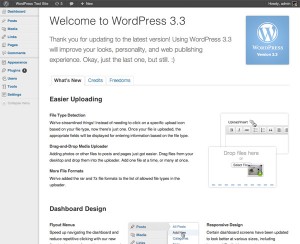Over the past few years, many of us in this webby world have come to depend on the open-source website platform, WordPress. This community-built software has evolved from a simple blogging tool to a robust site content management system (CMS) with plugins that instantly extend functionality with e-commerce, social networking, rich media, and much more. It continues to evolve with it’s latest release a signficant improvement in a number of areas we have been asking for. This article spotlights the major ones.
excerpts from an article by Japh Thomson
New media uploader
This version introduces a new media and file uploader with drag and drop uploading! That’s pretty exciting, and makes life a lot easier if you’re having to upload a lot of files. As we’ve come to expect from a lot of fun new things, the drag and drop uploading won’t work on older versions of Internet Explorer (but you’re not using Internet Explorer anyway, right?).
The new uploader also combines the various upload buttons that were there before into a single upload button, and has built-in file type detection. Support for uploading .rar and .7z files has been added too.
Improvements to the dashboard
There are some really nice improvements to WordPress’ dashboard in version 3.3. Where we used to have a strange mix of the admin bar and the admin header, they’ve been combined into a single admin toolbar. Of course, now that there’s just the single toolbar, the option to turn the admin bar off has been removed.
More and more people are wanting to manage their WordPress-based sites from their iPad or other tablet or touch devices, and there’s now better support for these. This includes better handling of touch, as well as a few responsive enhancements to ensure everything scales nicely on the smaller screens these devices have.
Ever been annoyed at having to click multiple times to get from one screen to another in the admin? Well you shouldn’t have to worry about that much anymore, as the menus in admin now fly out when you hover over them, allowing you to get to most screens in a single click!
User experience improvements
As if we hadn’t had enough user experience improvements on the dashboard already, there’s more! These improvements are mainly based around making the whole installation and update procedures much friendlier.
There are now feature pointers which provide tips around the various WordPress admin screens when there are new features added. These help highlight what’s changed in the new version and give an idea of what the new feature does.
We also have a screen that will be shown to users after an update is run with a brief summary of what’s new and improved in the updated version of WordPress, and a welcome screen for brand new users just logging into their freshly installed WordPress (those lucky people don’t even know what delights await them!).
Improvements to content-related tools
If you run a WordPress site with multiple authors, co-editing could sometimes be painful with WordPress locking a post to a particular author and leaving it locked for too long. No more! In 3.3 this has been improved and content locks are now released immediately for a smoother co-editing experience.
For people who have content on Tumblr that they’d like to move across to WordPress, there’s now an importer for that. The process of migrating your hosted Tumblr blog to a self-hosted WordPress install just got a lot less painful.
Speaking of less painful, if you’ve been trying a few different themes on your site and then gone to look at your collecting of widgets to find a mess, this new version should improve that for you too. Widgets are saved when switching between themes, and if you want to quickly try a new theme and decide to switch straight back, all your widgets will be as you originally had them. Magical!
Under the hood improvements
For as long as WordPress has been around, if you had a large number of pages / posts and were using /%postname%/ as your permalink structure, you were suffering a pretty big performance hit. When users accessed your pages, and when you published or edited your pages, there was a bit of waiting to do. The problem only got worse the more content you had. Luckily, the WordPress team have sorted this issue out, and there are now “massive performance gains” to be had with this update if you’re using that structure.
A number of new and improved APIs have had some TLC too, including the Editor API, the Screen API for adding help tabs and adapting to different screen contexts, and the Metadata API.
A few of the external libraries and extras used in WordPress have been updated to more recent versions, including jQuery upgraded from 1.6.1 to 1.7.1, jQuery UI upgraded from partial 1.8.12 to the complete 1.8.16 (including widgets and effects), and TinyMCE upgraded to 3.4.5.
WordPress will now clean up after itself when theme and plugin files are uploaded to be installed. The files uploaded will be deleted from WordPress’ file structure once the install is complete.
Another thing that theme developers will appreciate is that you are now able to use wp_enqueue_script() and wp_enqueue_style() within the HTML body. This means that if you have some specific functionality in a page template in your theme, you can include any scripts or styles right there, and they’ll be added in the theme’s footer.
More to come on this subject in future posts

